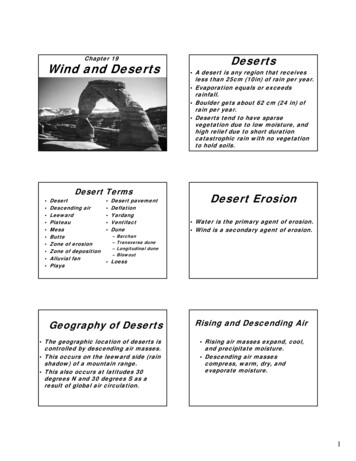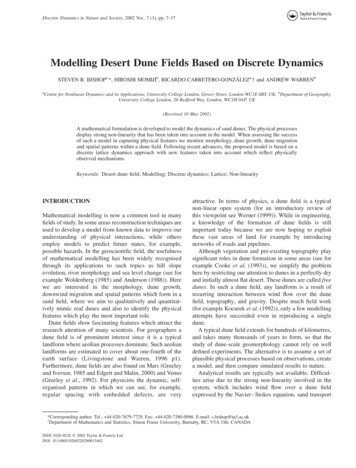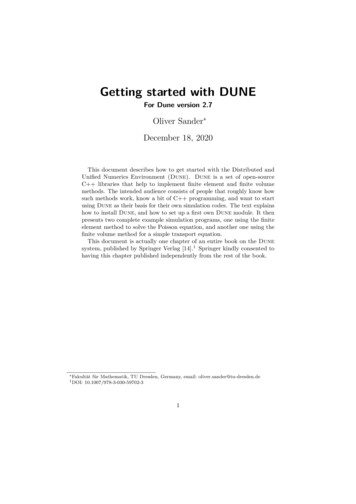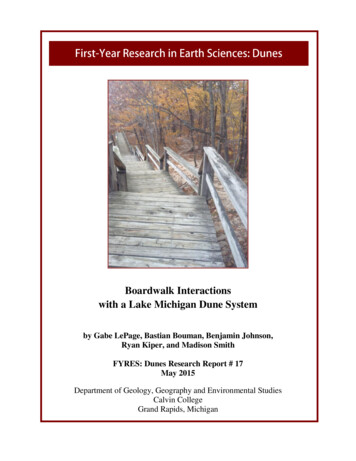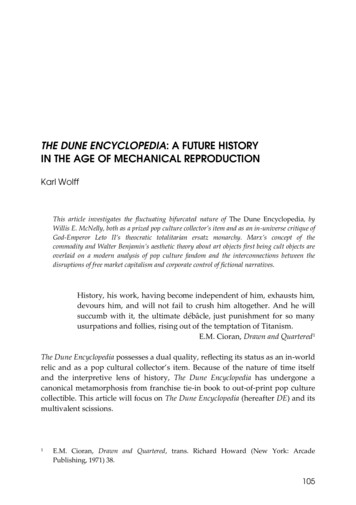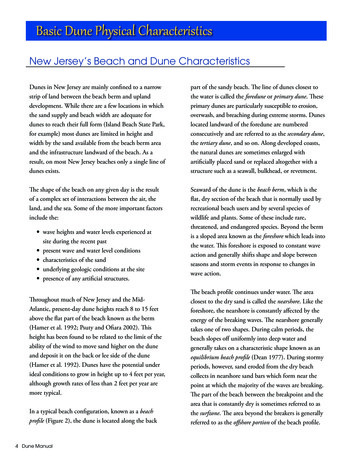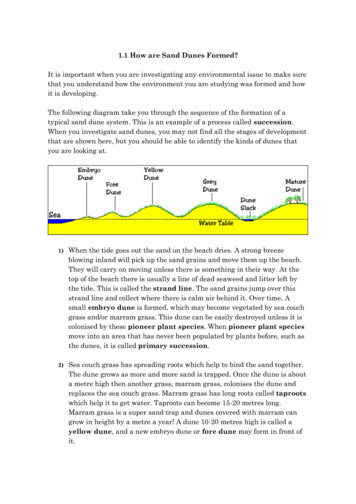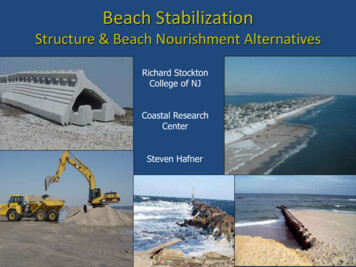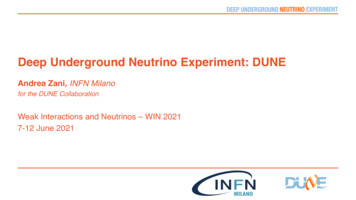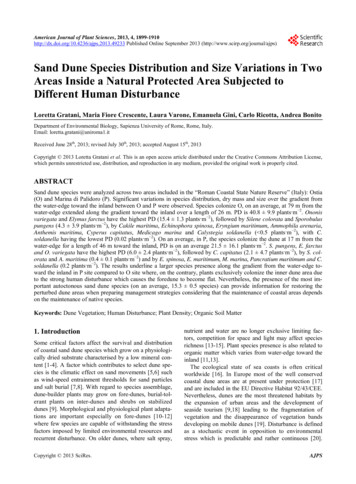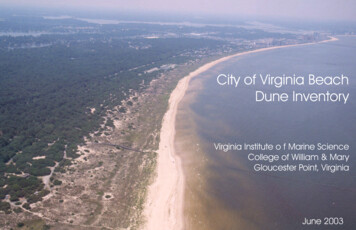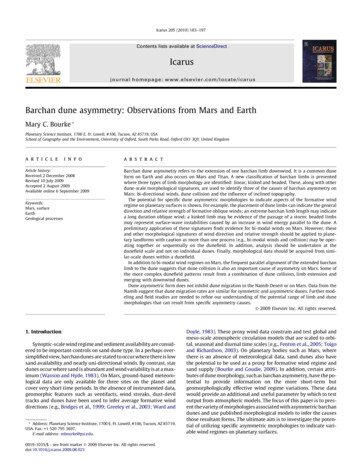
Transcription
Icarus 205 (2010) 183–197Contents lists available at ScienceDirectIcarusjournal homepage: www.elsevier.com/locate/icarusBarchan dune asymmetry: Observations from Mars and EarthMary C. Bourke *Planetary Science Institute, 1700 E. Ft. Lowell, #106, Tucson, AZ 85719, USASchool of Geography and the Environment, University of Oxford, South Parks Road, Oxford OX1 3QY, United Kingdoma r t i c l ei n f oArticle history:Received 2 December 2008Revised 10 July 2009Accepted 2 August 2009Available online 6 September 2009Keywords:Mars, surfaceEarthGeological processesa b s t r a c tBarchan dune asymmetry refers to the extension of one barchan limb downwind. It is a common duneform on Earth and also occurs on Mars and Titan. A new classification of barchan limbs is presentedwhere three types of limb morphology are identified: linear, kinked and beaded. These, along with otherdune-scale morphological signatures, are used to identify three of the causes of barchan asymmetry onMars: bi-directional winds, dune collision and the influence of inclined topography.The potential for specific dune asymmetric morphologies to indicate aspects of the formative windregime on planetary surfaces is shown. For example, the placement of dune limbs can indicate the generaldirection and relative strength of formative oblique winds; an extreme barchan limb length may indicatea long duration oblique wind; a kinked limb may be evidence of the passage of a storm; beaded limbsmay represent surface-wave instabilities caused by an increase in wind energy parallel to the dune. Apreliminary application of these signatures finds evidence for bi-modal winds on Mars. However, theseand other morphological signatures of wind direction and relative strength should be applied to planetary landforms with caution as more than one process (e.g., bi-modal winds and collision) may be operating together or sequentially on the dunefield. In addition, analysis should be undertaken at thedunefield scale and not on individual dunes. Finally, morphological data should be acquired from similar-scale dunes within a dunefield.In addition to bi-modal wind regimes on Mars, the frequent parallel alignment of the extended barchanlimb to the dune suggests that dune collision is also an important cause of asymmetry on Mars. Some ofthe more complex dunefield patterns result from a combination of dune collision, limb extension andmerging with downwind dunes.Dune asymmetric form does not inhibit dune migration in the Namib Desert or on Mars. Data from theNamib suggest that dune migration rates are similar for symmetric and asymmetric dunes. Further modeling and field studies are needed to refine our understanding of the potential range of limb and dunemorphologies that can result from specific asymmetry causes.Ó 2009 Elsevier Inc. All rights reserved.1. IntroductionSynoptic-scale wind regime and sediment availability are considered to be important controls on sand dune type. In a perhaps oversimplified view, barchan dunes are stated to occur where there is lowsand availability and nearly uni-directional winds. By contrast, stardunes occur where sand is abundant and wind variability is at a maximum (Wasson and Hyde, 1983). On Mars, ground-based meteorological data are only available for three sites on the planet andcover very short time periods. In the absence of instrumented data,geomorphic features such as ventifacts, wind streaks, dust-deviltracks and dunes have been used to infer average formative winddirections (e.g., Bridges et al., 1999; Greeley et al., 2003; Ward and* Address: Planetary Science Institute, 1700 E. Ft. Lowell, #106, Tucson, AZ 85719,USA. Fax: 1 520 795 3697.E-mail address: mbourke@psi.edu.0019-1035/ - see front matter Ó 2009 Elsevier Inc. All rights reserved.doi:10.1016/j.icarus.2009.08.023Doyle, 1983). These proxy wind data constrain and test global andmeso-scale atmospheric circulation models that are scaled to orbital, seasonal and diurnal time scales (e.g., Fenton et al., 2005; Toigoand Richardson, 2003). On planetary bodies such as Mars, wherethere is an absence of meteorological data, sand dunes also havethe potential to be used as a proxy for formative wind regime andsand supply (Bourke and Goudie, 2009). In addition, certain attributes of dune morphology, such as barchan asymmetry, have the potential to provide information on the more short-term butgeomorphologically effective wind regime variations. These datawould provide an additional and useful parameter by which to testoutput from atmospheric models. The focus of this paper is to present the variety of morphologies associated with asymmetric barchandunes and use published morphological models to infer the causesthose resultant forms. The ultimate aim is to investigate the potential of utilizing specific asymmetric morphologies to indicate variable wind regimes on planetary surfaces.
184M.C. Bourke / Icarus 205 (2010) 183–1972. Taxonomy of asymmetric limb morphology on MarsBarchan asymmetry refers to the extension of one barchan limbdownwind. In some deserts on Earth, asymmetry is so prevalentthat symmetrical barchans are thought to be the exception (Mainguet, 1984). Barchan asymmetry has been identified on other bodiesin our Solar System including Mars (Edgett and Malin, 2000) (Figs. 1and 2) and Titan (Radebaugh et al., in press).Dune asymmetry is common on Mars, affecting dunes of allsizes. At many sites the same limb is extended on all dunes(Fig. 1a and b). At other locations, however non-uniform patternsof limb extension may predominate (Fig. 2) even leading to superposition of limbs (Fig. 2d). Resultant dunefield ridge patterns canbe highly complex (Fig. 2a) suggesting that there are several causesof dune asymmetry on Mars.Barchan limbs on Earth and Mars display discrete morphologies. These have not been previously described or classified.Three classes of limbs are identified. These provide distinct morphological signatures that may be useful in identifying formationcontrols such as individual windstorms or dune collision events.Limb morphology is broadly categorized here as linear, beadedand kinked.Linear limbs are generally straight, but can have seif-like form.They can taper downwind (Fig. 3c and d) or assume a more roundedtermination (Fig. 3b). Some have well developed crestlines (Fig. 3c)and others have slipfaces, generally on the dune-ward side(Fig. 3a). The majority of linear limbs on Mars have neither crestlinesnor slipfaces. This may be due to the formative mechanism, a periodof quiescence in limb extension, induration or because a crestline isun-resolvable at the available image resolution.The second class, beaded limbs, have relatively broad, roundedand high sections that alternate with relatively narrow, low sections, resembling a string of beads (Fig. 4). For some limbs, thebroadest section occurs at the tip (Fig. 4b and d).Kinked limbs have a distinct, angular change in downwindalignment followed by straight sections of variable length(Fig. 5). The apex of the kink often has a well developed slipface.Some limbs have several kinks with tortuous sinuosity or unusuallimb alignment (Fig. 6).Limb morphologies on barchanoid dunes are similar to thoselisted above, but of note is the extreme length of the asymmetriclimbs and also on occasion, the symmetric extension of both limbs(Fig. 2b). Barchanoid dunes on Earth have not been noted to displaythis morphology.Fig. 1. Examples of barchan asymmetry on Mars. The same limb extends on each dune across the dunefields. (a) Mars orbiter camera (MOC) narrow angle image R2300624,75.16 W; 73.55 N, 5.09 m/pixel. Illumination is from the right. Box shows location of (c). North is at top left. (b) MOC narrow angle image E1601828, 82.40 W, 79.56 N,6.76 m/pixel. Illumination is from the right. Box shows location of (d). North is top right. (c) Subset of (a) above. (d) Subset of (b) above.
M.C. Bourke / Icarus 205 (2010) 183–197185Fig. 2. Examples of barchan asymmetry with a complex limb extension pattern and unusually long limb lengths. (a) Alternate limb extension on juxtaposed barchan andbarchanoid dunes lead to complex dunefield patterns. MOC narrow angle image E0200131, 245.85 W; 77.8 N, 4.87 m/pixel. Illumination is from the left. North is top right.(b) Example of asymmetry on barchanoid dune. Note the long length of the extending limb. The adjacent dune to the bottom is an example of extension of both limbs. MOCnarrow angle image M0202835, 255.24 W; 78.66 N, 3.22 m/pixel. Illumination is from the left. North is top right. (c) Barchanoid dune with asymmetric barchan in interdune.Note the different orientation of the two dunes. This illustrates the role of dune scale in dune reconstitution. It also suggests a complex wind patterns in the interdune. MOCnarrow angle image M0202629, 240.67 W; 76.70 N, 3.22 m/pixel. Illumination is from the left. North is towards top of image. (d) Opposite limb asymmetry in a north polardunefield leading to limb superposition. MOC narrow angle image E0101781, 256.02 W; 76.67 N, 4.86 m/pixel. North is top right of image and illumination is from thebottom left.3. Causes of barchan asymmetry on EarthOn Earth, four causes of dune asymmetry have been identified.First, it is proposed to be a response to bi-directional winds (Bagnold, 1941; Holm, 1960; King, 1918; McKee, 1966; Melton, 1940;Norris, 1966; Tsoar, 1984). Second, asymmetry is caused by dunecollision (Close-Arceduc, 1969; Hersen and Douady, 2005). Third,it is caused by asymmetry in sediment supply (Rim, 1958) andfourth, it is associated with variations in topography such as localbreaks in slope (Finkel, 1959; Long and Sharp, 1964). Of these fourmechanisms, the bi-directional model has received most attention.Data in support of the remaining three mechanisms are few andtheir efficacy remains to be demonstrated and fully understoodin a field context. These four models of barchan asymmetry are described below.3.1. Bi-directional wind modelsPredominantly bi-directional wind regimes have been shown tocause the preferential extension of a barchan limb.The effect of variable wind direction and relative strengths arediscussed in two models. The more frequently cited model is thatproposed by Tsoar (1984). He proposes that the barchan dune isoriented parallel to the strong wind regime and is modified bythe gentler winds that trend oblique to the barchan. The limb furthest from the approaching gentle wind is extended and the closestlimb is eroded (Fig. 7a). The longer limb is extended by obliquewinds in a manner similar to the development of seif dunes (Tsoar,1978, 1982, 1983).An example of dunes formed in a bi-modal wind regime arelocated in Peru (Fig. 8a). These dunes have asymmetric development of the western limb, likely caused by the less frequent,gentler oblique winds from the SSE (157 ) (Fig. 8b). Similarly,the dunes at Doha, Qatar (Fig. 9) show asymmetry of the western limbs likely influenced by winds from the north and northnortheast. Fig. 9b shows that the dunefield is subject to windsfrom a variety of directions. This indicates that the interpretationof a strictly bi-modal regime using dune asymmetry may exclude other important sediment transporting wind directionsthat occur in the region.
186M.C. Bourke / Icarus 205 (2010) 183–197Fig. 3. Examples of linear asymmetric limbs on Mars and Earth. (a) Asymmetric dune in Herschel crater. HiRISE image PSP 2728 1645, 131.9 E; 15.1 S, 25 cm/pixel.Illumination is from the left. North is at top of image. (b) Dune in the North Polar area. The limb appears to have a low height relative to the body of the dune. There is a slightbulge at tip suggesting the potential for calving of a dome from the limb tip. Inset shows ripples parallel to dune orientation. HiRISE image PSP 001660 2570, 76.7 N; 109.6 E,50 cm/pixel. Illumination is from the bottom left. North is at top of image. (c) Linear morphology with sharp crestline. The long limb length suggests a long duration obliquewind. MOC narrow angle image E0200131, 245.85 W; 77.8 N, 4.87 m/pixel. Illumination is from the bottom left. North is top right of image. (d) Tapered linear limb in Qatar,25 30 8.7200 N, 51 230 39.7100 E. Image used with permission from Google Earth. Illumination is from the bottom and north is to the top of the image.Fig. 4. Examples of beaded limb morphology on Earth and Mars. (a) Beaded limb, Peru, 15 60 44.1400 S, 75 150 31.7200 W. Illumination is from the top and north is to the top ofthe image. Image used with permission from Google Earth. (b) Well developed bead forms (proto domes?) on barchan limb. The limb on the northern dune appears to havecalved from the barchan dune. MOC narrow angle image E0400575, 262.62 W; 76.06 N, 4.85 m/pixel. North is to top right of image and illumination is from the bottom right.(c) Two elongate beads on a small barchan. MOC narrow angle image M0202629, 240.67 W; 76.70 N, 3.22 m/pixel. North is at top of image and illumination is from thebottom left. (d) The larger bead at the limb tip is a proto-dune or it may be the resultant morphology of the downwind merging of an extending limb with a small barchan/dome dune (see also dune in (b), above). MOC narrow angle image E0200045, 260.41 W; 76.21 N, 4.85 m/pixel. North is at top right of image and illumination is from the left.
M.C. Bourke / Icarus 205 (2010) 183–197187Fig. 5. Examples of kinked limb morphologies on Earth and Mars with slipface development on the dune-ward side of the limb. (a) Kinked limb, Peru, 14 450 53.5600 S;75 280 56.2300 W. Illumination is from the top right and north is to the top of the image. Image used with permission from Google Earth. (b) Kinked limb, Mars, MOC narrowangle image E0200039, 235.5 W; 79.35 N, 4.88 m/pixel. Illumination is from the bottom left. North is at top of image. c) Kinked limb, Mars, MOC narrow angle imageM0204193, 239.61 W; 76.72 N, 3.22 m/pixel. Illumination is from the left and north is to the top of the image. (d) Kinked limb, Mars, MOC narrow angle image M0204193,239.61 W; 76.72 N, 3.22 m/pixel. Illumination is from the bottom and north is to the top right of the image.Fig. 6. Examples of unusual kinked morphologies including tortuous sinuosity (a) and ‘question mark’ morphology (c). (a) Tortuous sinuosity. MOC narrow angle imageM0202835, 255.24 W; 78.66 N, 3.22 m/pixel. Illumination is from the bottom left and north is at top of image. (b) Seif-like morphology but with distinct kink (arrow). MOCnarrow angle image M0202835, 255.24 W; 78.66 N, 3.22 m/pixel. Illumination is from the bottom left and north is at top of image. (c) ‘Question mark’ dune. MOC narrowangle image M0202835, 255.24 W; 78.66 N, 3.22 m/pixel. Illumination is from the bottom left and north is at top of image.
188M.C. Bourke / Icarus 205 (2010) 183–197Fig. 7. Schematic of models of dune asymmetry caused by bi-modal wind regimes and dune collision. Arrow orientation indicates wind direction and arrow head sizeindicates relative strengths of winds. (a) After Tsoar (1984). (b) After Bagnold (1941). (c) Dune collision (absorption) (Endo et al., 2004). (d) Dune collision (impending)(Hersen and Douady, 2005).Fig. 8. An example of dune asymmetry caused by bi-modal winds as proposed by Tsoar (1984). (a) Asymmetric barchan dunes in Peru. The main wind directions that formedthe barchans is oblique to the elongated left horn. Image used with permission from Google Earth. Illumination is from the top right and north is to the top of the image. (b)Sand rose calculated for San Juan de Marcona airport, Peru (1973–1993) located approximately 30 km south of dunes in (a). Figure shows the drift potentials (DP – bluevectors), resultant drift direction (RDD – red vector) or net trend of sand drift under the influence of winds from different directions, and resultant drift potential (RDP). Thelength of the blue line indicates the frequency of each wind direction. The secondary drift potential (short blue line) from 157 leads to elongation of the western limb of thelarger barchans. Note that several of the smaller barchans are symmetric. (For interpretation of the references to color in this figure legend, the reader is referred to the webversion of this article.)Fig. 9. An example of dune asymmetry caused by bi-modal winds as proposed by Tsoar (1984). (a) Asymmetric barchan dunes in Doha, Qatar. The main wind directions thatformed the barchans is oblique to the elongated left horn. Illumination is from the bottom and north is to the top of the image. Image used with permission from Google Earth.(b) Sand rose calculated for Doha airport, (1973–1993) located approximately 30 km east of dunes in (a). The sand rose shows secondary winds from several directions (shortblue lines), but dominantly from 0 and 23 which should lead to elongation of the western limb of the larger barchans. It is notable that many of the smaller dunes aresymmetrical. (For interpretation of the references to color in this figure legend, the reader is referred to the web version of this article.)
M.C. Bourke / Icarus 205 (2010) 183–197The important role of bi-modal wind regimes was recognized byBagnold (1941, p. 223). He suggested that asymmetry was initiatedby storm events that are oriented oblique to the dune (and not gentler winds as proposed later by Tsoar). Asymmetry develops on thewindward barchan limb and is sustained and enhanced by gentlerwinds that parallel the barchan form (Fig. 7b). To date, only onefield example of Bagnold’s model has been identified (Lancaster,1980). Further, modeling studies have not successfully generatedbarchan asymmetry under Bagnold’s proposed wind regime (Parteli, 2007). Therefore, it would seem that while the concept of thebi-modal regime for dune asymmetry has survived the test of time,Bagnold’s inferred relative wind strengths and direction still remains to be proven. The presentation of the model is retained hereso that researchers may continue to look for evidence of Bagnold’sinferred wind directions.Relative wind duration may be as important as relative windstrength in causing the onset of asymmetry. A modeling study indicated that a barchan arm will elongate in the resultant direction ifthe oblique wind lasts longer than 25% of the duration of the primary wind (directional variability was modeled at 120 ) (Parteli,2007). Further field and modeling studies are required to establishthe importance of relative wind duration or relative wind strengthin the development of asymmetry.3.1.1. Dune collisionThe potential of dune collisions to distort morphology wasnoted by others but specific field examples are rare (Close-Arceduc,1969; Grolier et al., 1974). In a study of barchan and transversedunes in Antarctica the collision of small barchans into larger bar-189chan limbs downwind was suggested to contribute to the elongation of the target barchan limbs (Bourke et al., 2009a).Evidence of the efficacy of collision as a cause for asymmetrycomes predominantly from flume and modeling studies. Endoet al. (2004) undertook table top flume studies of two (a largeand a small) moving barchans in uni-directional water flow.Although not noted specifically in their study, their data show thatabsorption of the smaller impacting barchan by the larger downflow barchan led to the development of asymmetry (their figureis partly reproduced here as Fig. 7c).The impending collision of dunes may also cause an adjustmentof form. This was first noted by Shehata et al. (1992) who suggested that upwind dunes may modify the local wind regime soas to cause asymmetry in downwind dunes. This effect was demonstrated in a later modeling study (Hersen and Douady, 2005).It was found that where the impending collision is offset fromthe central axis of target dunes and the windward slope of thedownwind dune is eroded by the wake of the advancing smallerdune, sand is preferentially directed through one horn leading toits elongation (Fig. 7d).An additional collision model proposed that the extension andmerging of limbs with downwind dunes may enhance the lengthof the asymmetric arm (Bourke et al., 2009a). A time series of aerialphotographs from the Victoria Valley dunefield in Antarcticashowed that a downwind barchan was ‘captured’ by the extendinglimb of a larger upwind barchan to form a linear asymmetric arm.In the first time-step (1961), there are two dunes, the smaller ofwhich lies downwind of a barchan limb. In the next time-step(1981), these two dunes have merged by the attachment of theFig. 10. (a) Overview of dunefield in Sudan (18 480 12.5300 N, 25 100 20.4100 E) where collision is the likely trigger of barchan asymmetry. Illumination is from the lower rightand north is to the top of the image. Locations of image subsets (b–d) are indicated by boxes. (b) Example of impending collision causing limb extension. (c) Example ofalternate limb extension to dune in (b) with no evidence of collision. (d) Similar-size barchan collision with no asymmetric limb extension indicating that collision does notalways trigger asymmetry. (e) Limb merging with windward slope of barchan causing extension of limb. Location of dune is 380 km northeast of (a). Images used withpermission from Google Earth.
190M.C. Bourke / Icarus 205 (2010) 183–197limb to the windward slope of the smaller dune. In the final timestep (2001), the upwind dune is strongly asymmetric and thedownwind dune no longer exists (see Fig. 9d in Bourke et al.,2009a).Satellite images of a dunefield in Sudan show an example ofasymmetry caused by collision. There the collision and merging between an upwind limb and the downwind dune has caused extension of the south western limb (Fig. 10e). Fig. 10b is an example ofwhere the close approach of a dune causes asymmetry. At thedunefield scale, there are examples of symmetric dunes, duneswith northwest limbs extending (Fig. 10b) and dunes with southeast limbs extending (Fig. 10c). This dune form assemblage (atthe dunefield scale) may be the key morphologic signature to identify dune collision as a cause of barchan asymmetry. Further workis required on the role of collision in triggering barchan asymmetry, particularly to elucidate on examples where collision doesnot cause asymmetry (Fig. 10d).3.1.2. Asymmetric sediment supplyAn asymmetric sediment supply was demonstrated in laboratory experiments to be a potential cause of dune asymmetry(Rim, 1958). Lancaster (1982) suggested that the increased availability of sediment proximal to a dunefield in the Namib Desertcaused asymmetry in the barchan limbs closest to the sand seaFig. 11. The potential influence of topography in the development of barchan asymmetry in Peru. (a) Barchan dunefield migrating across landscape where resistant layers inunderlying bedrock protrude as low ridges (14 520 26.4300 S, 75 300 58.3100 W). Location of (b) is outlined by black box. Illumination is from the top and north is to the top of theimage. (b) Example of three barchans that extend their eastern limb across topographic rise. Wind regime in the area is bi-modal resulting in the extension of western limbs,except where influenced by topography (see Fig. 8b for regional sand rose). Images used with permission from Google Earth.
M.C. Bourke / Icarus 205 (2010) 183–197margin. The author has undertaken a search of sand seas globallyand has not identified examples of asymmetric dunes in closeproximity to the sand sea margin, except where the influence ofbi-modal wind regimes is likely.3.1.3. TopographyThe interaction of barchans with local topography (e.g., gulliesand bedrock exposures) can distort dune shape and lead to asymmetry (Long and Sharp, 1964). In addition, sloping surfaces can alsocause asymmetry. Finkel (1959) attributed the asymmetric extension of the western limb of dunes in Peru to the westward slopingsurface. However, others have noted symmetrical dunes migratingalong a 23 slope in Peru (Gay, 1999, his Fig. 11) suggesting that theunderlying slope may not always trigger asymmetry.A topographic influence is suggested for the barchans in Fig. 11.This dunefield is located close to the dunes in Fig. 8 and the bimodal wind regime for this region suggests that the western limbshould extend. However in these examples, the eastern limbs areextended as the dunes approach and cross a topographic break inslope, suggesting that topography can cause barchan asymmetry.To date there has not been any focused study on the role oftopography in causing dune asymmetry. Further field and modeling studies are required to ascertain the role that topography playsin triggering asymmetry.4. Discussion191placement of the asymmetric arm. In Tsoar’s model (1984) described above, the asymmetric limb should have a distinct seifform and extend away from the barchan ( 120 azimuth)(Fig. 7a). A potential example of Tsoar’s model on Mars is illustrated in Fig. 12. The asymmetric limb extends away from the duneunder the influence of gentler oblique winds and the opposite limbappears eroded. If Tsoar’s inferred wind directions are applied, itsuggests strong winds parallel to the dune and gentler winds oblique to the extending limb.In Bagnold’s model (1941), (sensu stricto) the growing limb migrates across the front of the dune (Fig. 7b). Once it enters the sandstream from the opposite barchan limb, it receives sand from bothwind regimes and grows more rapidly than the connecting limband a new dune (or bead) is formed along the extending limb axis.Resultant limb morphologies include variable width, the development of a lee side slip face on the limb and/or new dune formation.Examples of the Bagnold model were difficult to find on Mars.One tentative example is shown in Fig. 13 where the extendinglimb crosses the path of the barchan. Slipfaces are difficult to detect at this resolution, but the downwind portion of the limb appears higher and wider than the mid-section suggestingpreferential growth at that location as suggested by the Bagnoldmodel (Fig. 7b). If Bagnold’s inferred wind directions are appliedto this example, it suggests strong winds oblique to the extendinglimb and gentler winds parallel to the barchan. It should be notedthat, in this example, proximity to the downwind dune may haveinfluenced the lateral migration/deflection of the limb.4.1. Identifying the cause of barchan asymmetry on Mars4.3. Morphological evidence of other causes of barchan asymmetryFrom a review of the literature it is clear that the complete rangeof controlling factors that cause dune asymmetry is not well studiedand this imposes limitations on the inferences that can be made. Thefollowing section is an attempt to interpret the cause of asymmetryusing morphological signatures that have been previously identifiedin the literature (summarized in Table 1). It is hoped that this workwill stimulate rigorous field and modeling studies to gain further insight into the range of factors causing asymmetry.Our current understanding of the influence of bi-modal windregimes is that they often produce asymmetric limbs that eithercross the dune path or trend away from it. There are many examples on Mars where neither case is true and the asymmetric limblies parallel to the dune orientation. This limb alignment may bean important morphological criterion indicating that additionalcauses of asymmetry operate on Mars (e.g., collision, asymmetricsediment supply or topography).4.2. Morphological evidence of a bi-modal wind regimeOn Earth asymmetric dunes that form in bi-modal winds havedistinct morphological attributes, the most notable being the4.3.1. Dune collisionDune collision includes both the effect of the proximity of anupwind dune and the merging, absorption and lateral linking ofTable 1Summary of morphological signatures on asymmetric barchans that suggest specific causes of asymmetry.CauseMorphological signatureBi-directional wind regime(Tsoar)– Extended limb extends away from dune slip faceorientation– Limb has seif form– Kinked limb– Extended limb lies across dune slip face orientation– Variable width (bead)– Lee side slip face on the limb– Dune upwind of asymmetric limb– Vestiges of dune on windward slope– Alternate arms extend on dunes in same dunefield– Limb parallel to dune– Beaded limb– Kinked limb (tortuous sinuosity)– Excessive limb length– Kinked limb– Excessive length of limb– Limb is funnelled through topographic low– Alternate limb extension over break in slope– Extended limb correlates with dip of slope– Limb closest to dunefield is extended– Extended limb is aligned along transport pathstreamer from point sourceBi-directional wind regime(Bagnold)Dune collision (including closeproximity)Storm event/long durationoblique windTopographyAsymmetric sediment supplyNotesLimited evidence to support the inferred wind directions on Earth or MarsCollision process may explain highly disorganized dunefield patterns andthe extreme length of limbsLimited evidence to support this mechanism on Earth or Mars
192M.C. Bourke / Icarus 205 (2010) 183–197Fig. 12. Asymmetric dunes on Mars caused by a bi-directional wind regime similar to that proposed by Tsoar (1984). (a) The placement of the limb away from the dune andthe seif-like limb morphology suggests that the predominant wind is parallel to the barchan (large arrow) while a more gentle oblique wind blow across the dune (smallarrow). MOC NA image E02-00732, 3.24 m/pixel, 103.9 W, 77.66 N. Illumination is from the top left and north is towards the bottom right. (b) An asymmetric barchan wherethe barchan limb has a distinct seif morphology and extends away from the dune. The larger arrows indicate the direction of the inferred strongest winds and the smallerarrows indicate the direction of the relatively gentle winds. The white arrow indicates the direction of seasonal defrosting wind streaks suggesting a third wind direction.HiRISE image PSP 008208 2600, 245.9 E; 80.0 N, 25 cm/pixel. Illumination is from the right and north is towards the bottom right.dunes. Morphological evidence that an approaching dune causedasymmetry woul
dune-scale morphological signatures, are used to identify three of the causes of barchan asymmetry on Mars: bi-directional winds, dune collision and the influence of inclined topography. The potential for specific dune asymmetric morphologies to indicate aspects of the formative wind regime on planetary surfaces is shown.
